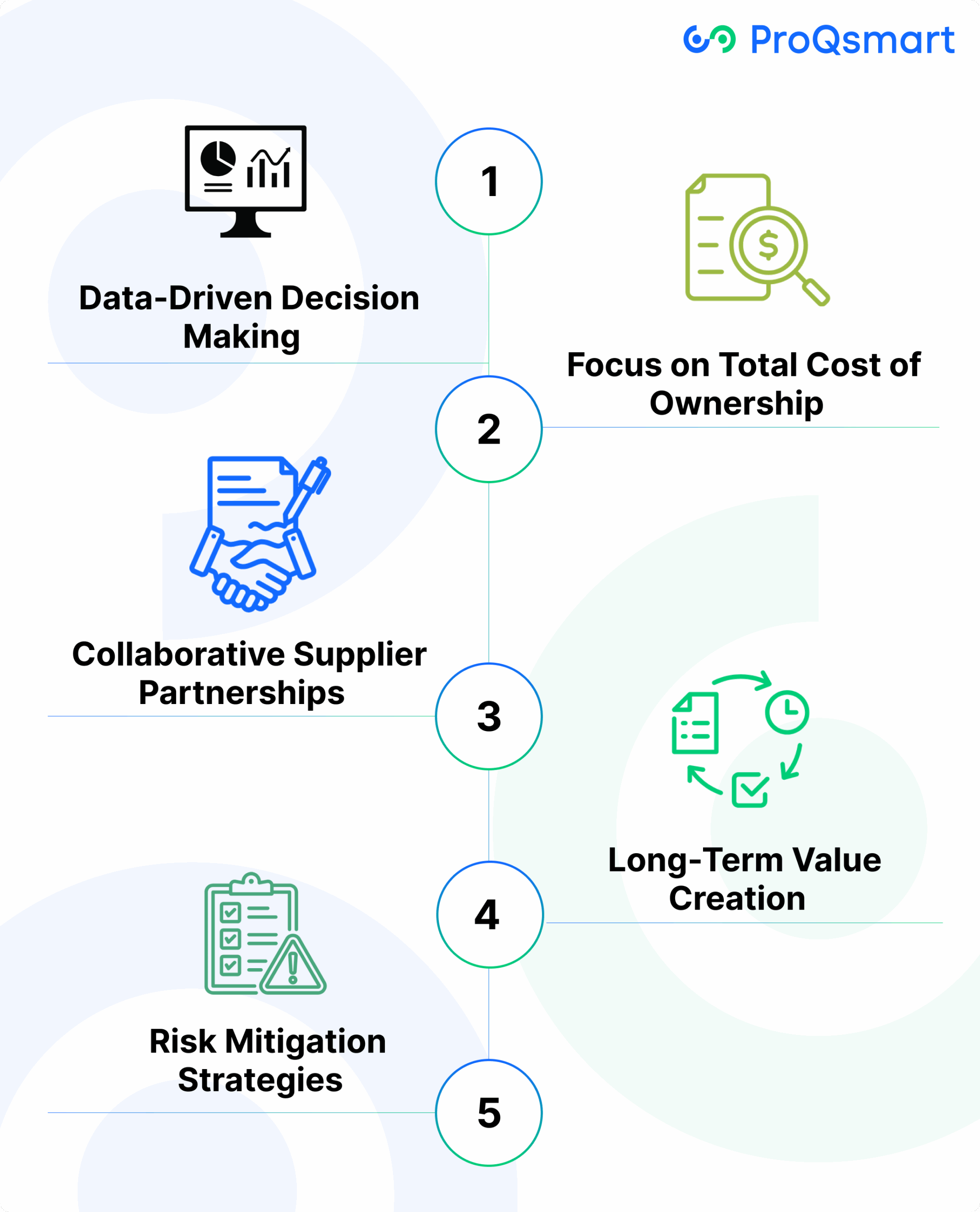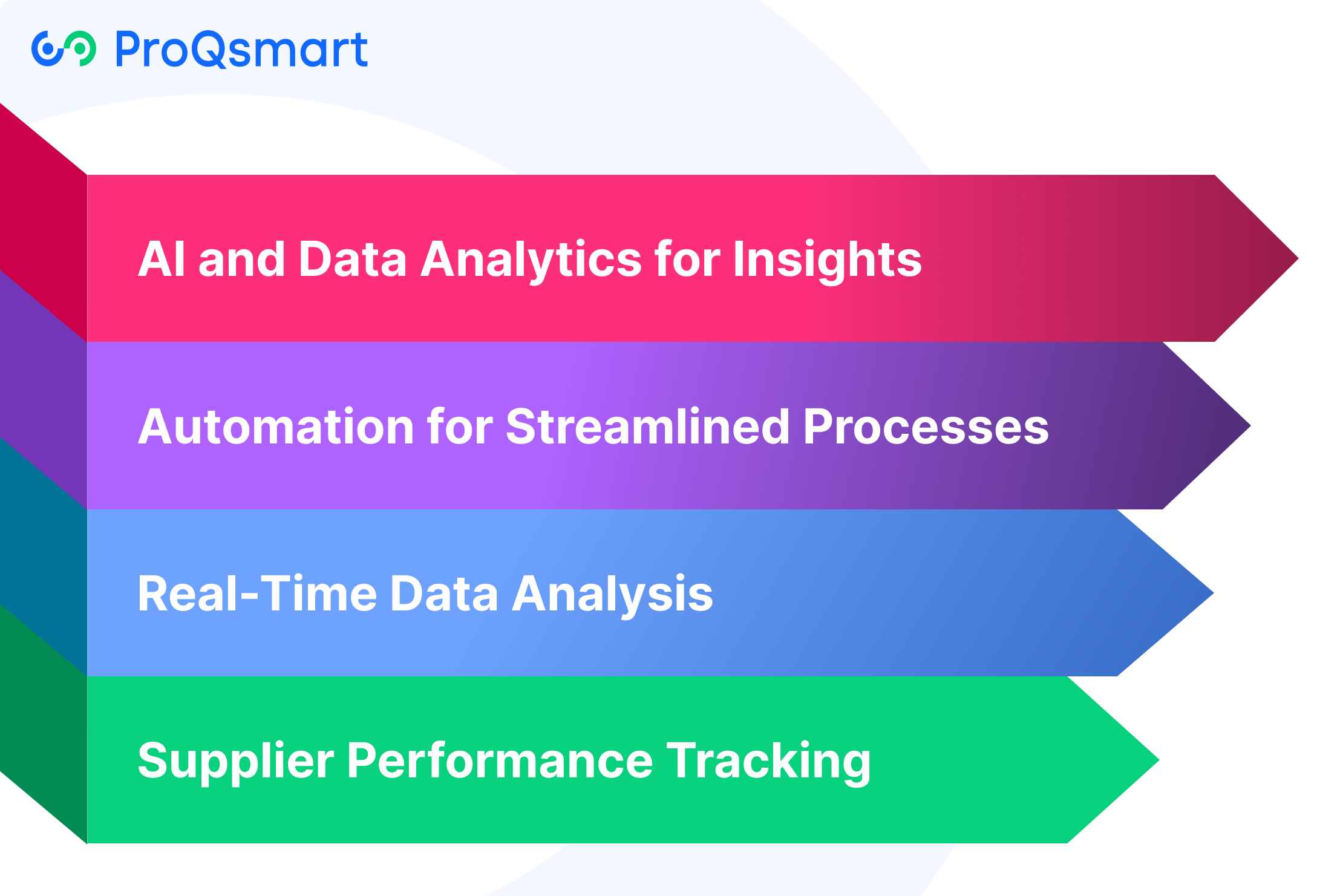Strategic sourcing focuses on optimizing procurement processes by identifying and building strong relationships with suppliers to meet organizational goals efficiently. It advocates for a rigorous, data-backed methodology to uncover patterns in their spend, benchmark their supplier performance, and optimize their contracts with suppliers to support their business goals.
By placing value over cost, strategic sourcing delivers long-term rewards like lowered risks, better quality, and sustained development. It serves an essential purpose for companies of all stripes in America. They depend on it to proactively respond to emerging supply chain disruptions and evolving regulatory demands.
Whether you’re looking to increase workflow efficiency or improve supplier relationship management, strategic sourcing provides you with practical tactics to create real-world impact. In this blog, we’ll cover the foundational principles, tools and best practices to ensure you’re getting the most from this powerful resource.
Why Strategic Sourcing is Important in Procurement Practices
Strategic sourcing is a systematic approach to procurement that aligns purchasing activities with organizational goals, emphasizing long-term supplier relationships and data-driven decision-making. Unlike traditional sourcing processes, it focuses on optimizing the total cost of ownership, fostering collaboration, and driving efficiency. By adopting a strategic sourcing plan, organizations can better manage their procurement operations.
Key benefits of strategic sourcing include consolidating purchasing power and leveraging market insights to secure favorable terms, ensure quality, and adapt to changing market conditions. This approach also mitigates risks by providing visibility into potential disruptions and enabling proactive contingency planning through effective supply market analysis.
- Enhanced supplier partnerships,
- Cost savings, and
- Improved operational resilience.
Strategic sourcing is not a one-time event but an ongoing process that evolves with business needs. Tools like spend analysis and market intelligence help organizations make informed procurement decisions that reduce costs and improve efficiency. Technology plays a critical role in simplifying this process—solutions such as ProQsmart enable automation of e-tenders, supplier performance tracking, and real-time budget monitoring, enhancing transparency in procurement workflows.
The integration of strategic sourcing systems allows for continuous improvement in supplier management and supplier development. By fostering strong supplier relationships and leveraging strategic sourcing capabilities, organizations can ensure they are prepared for future challenges in their supply chain management.
Core Principles of Strategic Sourcing

Strategic sourcing serves as the backbone of effective procurement, emphasizing strategic sourcing principles, supplier performance, risk mitigation, and robust supplier relationships.
1. Data-Driven Decision Making
Data analytics has transformed how we approach procurement. By leveraging tools like spend analytics, which 56% of organizations have implemented, we uncover savings opportunities and refine sourcing strategies. For instance, analyzing historical spend data can highlight patterns that inform better supplier evaluations and negotiations.
Monitoring supplier performance through data ensures that contracts meet expectations, while risk assessments based on analytics help prevent disruptions.
2. Focus on Total Cost of Ownership
TCO is about more than just upfront costs. A comprehensive TCO analysis considers costs over the lifecycle such as maintenance, logistics, and disposal. This holistic approach gives us a deeper and broader perspective to evaluate supplier proposals.
For instance, when awarded to the higher-priced supplier but with lower lifecycle costs, larger savings are typically achieved. By aligning procurement ambitions with TCO, we bolster supplier negotiations and commit to sustainable, lasting decisions.
3. Collaborative Supplier Partnerships
Getting the supplier involved in the development and building open and transparent relationships creates shared success and common growth. Together problem-solving and regular communication dramatically improve efficiency and collaboration, fostering mutual trust.
For instance, bringing the suppliers into early planning conversations can help spur innovative solutions that speed delivery of products and services. ProQsmart makes these collaborations more effective by automating workflows and making it easier to align procurement directly to budgets.
4. Long-Term Value Creation
Strategic sourcing focuses on building sustainable supplier partnerships that support overall business objectives and enhance supply chain management. Continuous improvement, backed by innovative strategic sourcing systems like ProQsmart, leads to long-term, sustainable success.
5. Risk Mitigation Strategies
Diversifying suppliers and implementing a strategic sourcing plan, along with regular risk assessments, are essential for ensuring supply chain resilience and minimizing disruptions.
Benefits of Strategic Supplier Alignment
Strategic supplier alignment is a key component of smart, modern procurement, providing many benefits that go far beyond just saving money. By implementing a strategic sourcing plan and aligning suppliers to their organizational goals, businesses can nurture resilient, innovative, and sustainable supply chain management, which provides long-term value.
Enhanced Collaboration and Innovation
A supplier relationship with strong alignment is established through continuous open communication and respect for one another’s priorities, creating an environment with collaboration at its core. When suppliers and organizations work strategically, together they can create revolutionary products.
This collaborative process results in innovative sustainable solutions that improve product quality and market competitiveness. Aligning strategic goals encourages suppliers to direct their efforts towards innovation and improvement, and regular feedback loops keep performance and engagement levels on track.
For instance, a manufacturer collaborating with a supplier on eco-friendly materials can achieve both sustainability targets and higher customer satisfaction.
Optimized Costs and Volume Discounts
By making strategic sourcing easier, aligned suppliers avail larger, consolidated purchasing, pushing down costs through volume discounts and more competitive pricing. It enables companies to use the power of competition among a healthy set of suppliers to drive down costs.
Digital platforms – such as ProQsmart, and others – are key to this cycle. They automate negotiation to deliver real-time insights, allowing for data-driven decisions that keep procurement in line with budget objectives.
Improved Supply Chain Resilience
Finally, supplier alignment is a key way to strengthen supply chain resilience through diversifying sources and proactively managing risks. By identifying your suppliers based on these important factors such as financial stability or compliance, you can avoid major disruption due to failures.
A study shows 80% of companies using strategic sourcing reported fewer disruptions, highlighting its importance for stability and business continuity.
Stronger ESG Alignment
Aligning supplier sourcing strategies to meet ESG requirements helps build a strong brand reputation and demonstrates a commitment to sustainability. Ethical sourcing reduces waste, protects labor practices, and aligns with regulations.
As a result, they are having a greater impact environmentally while ensuring their long-term business success.
Build a Strategic Sourcing Framework

Strategic sourcing is a disciplined, data-driven procurement process that enables organizations to reduce costs, improve supplier relationships, and achieve overall business objectives. By leveraging strategic sourcing systems, organizations can confidently make more effective procurement decisions that lead to measurable outcomes.
1. Analyze Internal Needs and Spending
To build the infrastructure, start by taking a look at procurement activities and spending habits. This can entail mapping out gaps where existing practices diverge from the true priorities and goals of an organization.
Through spend analysis tools,for instance, find inefficiencies such as redundant purchases or missed volume discounts. Aligning procurement with overarching business objectives creates the necessary assurance that every dollar spent is working to support long-term corporate strategies.
2. Conduct Thorough Market Research
Understanding supplier capabilities and market trends is critical. I evaluate suppliers based on quality, reliability, and alignment with goals.
For instance, utilizing the ProQsmart, helps categorize items by profit impact and supply risk, guiding sourcing decisions effectively. Staying informed about industry developments ensures we identify suppliers who meet both current and future needs.
3. Define Supplier Selection Criteria
Setting specific, measurable criteria for evaluation is critical. Considerations such as cost, quality, delivery lead times, and capacity/capability are hugely important.
As an illustration, ProQsmart’s strategic sourcing philosophy is built on reliable, values-aligned suppliers providing quality materials at appropriate prices with consistency to drive operational excellence.
4. Develop a Comprehensive Sourcing Plan
A granular sourcing plan considers factors such as selection criteria, negotiation tactics, and how to track performance measures.
ProQsmart’s AI-driven platform further accelerates this entire process by automating workflows, boosting compliance, and aligning procurement with district budgets to enable faster execution of projects.
5. Negotiate and Establish Agreements
When negotiating for the best possible terms, I advocate for a clear tone and a productive, long-lasting partnership in our agreements.
Clear and public agreements promote trust, cultivating stronger supplier relationships right from the start.
6. Implement Changes and Onboard Suppliers
Onboarding, open lines of communication, and in-depth education will help them onboard with ease.
ProQsmart’s tools help manage and monitor subcontractors, as well as track bills of quantities to make this phase easier.
7. Monitor and Evaluate Performance Continuously
Regular reviews with a set of KPIs are crucial for refining strategic sourcing processes. Feedback loops facilitate continuous improvement, keeping you aligned with your business objectives.
Strategic Sourcing Process: A Step-by-Step Guide
Strategic sourcing is a proven way to focus procurement activity in a more effective, efficient and systematic way. It provides better cost savings, supplier relationship management, and risk mitigation. This approach includes grouping similar purchases, such as manufacturing materials, to develop more focused strategies.
Here’s our comprehensive step-by-step guide to rolling out an effective strategic sourcing process.
Assess Current Spending Patterns
Reviewing past procurement data provides a clearer picture of spending trends and patterns to aid sort costs by the type or service provided. Understanding these categories helps buyers identify inefficiencies or areas where they may be overspending.
For example, realizing that there is a lot of wasteful office supply spending might result in renegotiating contracts or consolidating vendors. Currently, about 56% of organizations utilize spend analytics, so its significance in creating data-driven sourcing strategies speaks for itself.
Analyze the Supply Market
A thorough market analysis helps determine the best potential suppliers and what the market climate might be. This step includes analysis of things such as supplier capacity, upcoming trends, and competitive positioning among others.
Knowing what a supplier includes in their pricing model can help shape negotiations to avoid risks such as price shocks.
Evaluate Total Cost
Evaluating the total cost of ownership (TCO) guarantees value over time. By incorporating additional costs such as maintenance or sustainable delivery options, organizations can choose suppliers that provide more sustainable benefits.
By applying procurement AI to real-time cost analysis and making budget available, ProQsmart’s AI-smart platform helps public sector procurement drive transparency.
Identify Potential Suppliers
Developing a robust, diverse supplier base increases flexibility and helps you avoid potential disruptions. Vetting suppliers for quality, reliability, and risk factors assures that your awarded suppliers can meet organizational standards.
ProQsmart makes this easier by automating manual processes such as pre-qualifying and managing subs.
Develop Sourcing Strategy
Whether via a single or multi-sourcing strategy, tailored strategies better align with organizational goals. ProQsmart dives deeper with tools such as e-tenders and strategic sourcing systems, radically simplifying complicated strategic sourcing processes.
Monitor Supplier Performance
Defining and developing metrics to monitor suppliers’ adherence to the scorecard will help facilitate ongoing improvement in procurement operations. ProQsmart’s strategic sourcing systems make it easy to measure supplier reliability and contract compliance.
Technology’s Role in Strategic Sourcing

The advent of technology has drastically changed the procurement landscape, enhancing strategic sourcing processes and bringing unmatched levels of efficiency, transparency, and precision. By leveraging digital tools, procurement teams can streamline workflows, strengthen supplier relationships, and make informed procurement decisions rooted in actionable data.
AI and Data Analytics for Insights
AI-driven technology has opened up new avenues for procurement data analysis. Technology democratizes data analysis. Now teams can more easily identify patterns and trends that were previously difficult to isolate.
By harnessing predictive analytics, organizations can foresee changes in the market and refine their sourcing strategies while mitigating risks before they arise. AI continuously reviews spend data to proactively identify areas of cost savings within a catalog of tiered supplier offerings.
Moreover, it maintains accountability with regional planning laws. Platforms such as ProQsmart enhance the supplier evaluation process, offering immediate access to performance data that builds transparency, trust, and accountability.
Automation for Streamlined Processes
Automation takes much of the manual work out of the process leading to fewer errors and more time to focus on strategic activities. Once-menial tasks such as creating purchase orders and e-tendering have all been systemized.
This automation frees teams to focus on higher-value initiatives that deliver the most value. For instance, ProQsmart automates procurement workflows and subcontractor management with an impressive speed-up procurement cycle while reducing costly human errors.
Communication automation streamlines and strengthens supplier communication, automatically updating suppliers and ensuring smooth collaboration.
Real-Time Data Analysis
Control over high-quality, real-time data creates the possibility for sourcing teams to remain flexible and able to respond to market fluctuations quickly. Data visualization tools make complicated datasets more understandable, creating a clearer picture of what should factor into decision-making.
ProQsmart’s real-time tracking capabilities keep procurement within budget while keeping a close eye on supplier performance to ensure they are aligned with your organization’s objectives.
Supplier Performance Tracking
Regular tracking of supplier performance metrics helps keep expectations top of mind and ensure everyone is set up to deliver their best. When performance data is shared freely and transparently, a culture of continuous improvement is created along with stronger, more cooperative partnerships.
ProQsmart’s integrated supplier monitoring tools offer continuous monitoring and reporting, so you know when contract terms are being met or not.
Best Practices for Strategic Sourcing Success
Strategic sourcing takes a business-wide approach to ensuring that procurement strategies align with business objectives. By honing in on smart practices and leveraging strategic sourcing systems, organizations of any size can focus on maximizing their sourcing efforts while minimizing risks. Here are some of the best practices that have led to success in strategic sourcing processes.
Regular Strategy Reviews
Scheduling regular check-ins of sourcing strategies are important to making sure they stay effective over time. This requires evaluating market conditions, supplier performance, and your organization’s changing needs.
30% of all supplier data is outdated within one year. So, continuous monitoring is key to avoiding risk and remaining in line with our organizational objectives. Performance data gives you the ability to keep making changes, refinements and improvements to how you source.
Stakeholder and supplier feedback helps a lot too and is advisable, creating an environment of continuous improvement.
Stakeholder Engagement
Involving stakeholders from all departments helps you avoid creating sourcing strategies that are out of sync with your business’ priorities. Strategic alignment and collaboration between procurement, finance and operations teams fosters comprehensive decision-making.
Communication of goals and expectations ensures cohesive plan execution. For example, including engineering teams in the supplier selection process might have mitigated the situation by verifying technical compatibility.
Stakeholder engagement is the foundation of initiatives such as preferred supplier programs that strengthen supplier relationships and create value.
Invest in Technology
Investing in state-of-the-art procurement resources maximizes sourcing impact and effectiveness. Platforms including ProQsmart make the intimidating process easy with tools including AI-based decision making, e-tendering, and real-time collaboration.
Automation enables these data-driven decisions by generating risk profiles using data from multiple sources. At the same time, tracking supplier performance ensures ongoing compliance and quality.
With 70% of companies prioritizing digital transformation, technology integration is crucial for competitive advantage.
Conclusion
Strategic sourcing is a transformative approach to procurement that drives meaningful change by aligning supplier relationships, cutting costs, and enhancing efficiency. By focusing on clear outcomes and leveraging technology, organizations can streamline processes and make informed decisions that benefit all parties involved. This methodology shifts procurement from a transactional function to a strategic driver of business success.
Resilient sourcing frameworks not only optimize operations but also foster superior public-private partnerships and provide a competitive edge in the market. Technology amplifies these efforts, increasing both speed and accuracy while enabling smarter workflows. Strategic sourcing, when fully embraced, becomes value sourcing—delivering long-term sustainability and operational soundness.
To explore how ProQsmart can help you implement strategic sourcing practices with cutting-edge tools and insights, book a demo today and take your procurement strategy to the next level.




